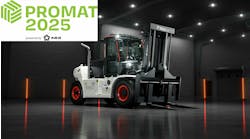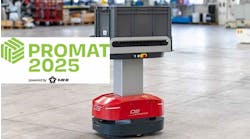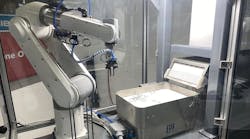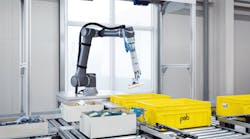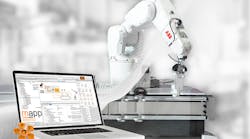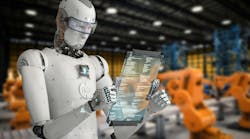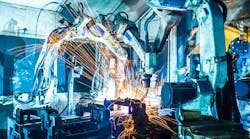Want a Smarter Production Line? It’s Time To Get Flexible
A common element of many operations and an effective way of automating production lines, vibratory feeders are used to align and feed small products and parts during the assembly and production process using gravity and vibrations.
However, they're notorious for being unreliable, rigid, and lacking the flexibility needed for an agile and adaptable production line.
To address these limitations found in standalone vibratory feeders, EPF engineering has developed the Supata system—a fully realized robotic solution, suitable for use in any industrial production setting.
Its unique features make it ideal for manufacturing and production in the automotive, technical, medical, and electronics industries where precision and speed are invaluable.
The Supata consists of a feeding system, a vision system, a robotic handling system, and a control system (HMI). It has been designed for manipulating and singularizing products and components for quick and precise assembly.
Its vibratory Smart Feeder system, made up of a vibrating table and a hopper, allows it to handle components of various sizes, shapes or materials—ranging from less than 0.4 inches to over 9.8 inches in size and 25 to 350 grams in weight. This gives it versatility when integrating the Supata into new or existing production lines.
The machine comes with a vision system with artificial intelligence (AI) for accurate recognition and high precision to identify and locate components on the vibratory plane using a camera which then passes coordinates on to the robot for picking.
The software is straightforward for reconfiguring changes in production and has integrated quality control for whatever components are handled, making it able to adapt to operator requirements.
The AI can also reduce the number of errors, increasing productivity by 17 to 20%.
The Supata comes with a Shibaura Machine robot as its handling system which users can customize by choosing six-axis, SCARA or collaborative robots depending on their requirements.
Both SCARA and six-axis robots are ideal for pick-and-place applications due to their large range of movement and high precision, and with the Supata the robot can place components wherever required by the operator.
SCARA robots can work at high speeds on four axes and are suited to small-scale applications requiring accuracy and precision.
Six-axis robots have superior directional control thanks to their articulation and movement on two additional axes and are capable of advanced movement profiles and intricate processes.
The control and monitoring system (CMS) is an integral part of the system. Run using edge-computing technology, the machine has been developed for Industry 4.0. The CMS also allows remote connection so that operators can monitor machine functions from any location for access and analysis.
In terms of physical integration, the Supata can be configured to fit into existing workshops and production lines with ease. The chassis is tough and durable to withstand long-term use in an industrial environment and minimize the risk of damage.
Additionally, it's available in different designs and sizes; Buyers can choose a fixed structure or a versatile mobile chassis with various docking stations to meet different needs.
A key advantage of a fully integrated solution is the ability to maintain a constant cycle time, with the potential to reach one part per second. The easily configurable system can also handle a huge range of materials and geometries and operates from a single interface, making it a simple and user-friendly system that is easy to adapt to a range of applications.
An important feature of Supata is that it's a fully engineered system. Many other suppliers can provide single components, but this is much more complex to incorporate into existing assembly lines. By supplying a modular station containing a complete solution, this is much easier to integrate into new and existing lines.
Modern manufacturing can be fluid, with frequent changes to products or formulations, and equipment should be as agile as possible to facilitate this. Supata can be used to produce small batches with frequent changes and is fully configurable depending on the application.
The straightforward, plug-and-play system is always ready to manage new products of different types from a single interface, and its AI algorithms can reduce costly errors and significantly improve turnover.
For operations requiring vibratory feeding, equipment that's able to keep up with the demands of Industry 4.0 is more important than ever. Choosing an integrated and innovative solution can not only improve productivity and cut costs but can help to create an agile and futureproof line.

